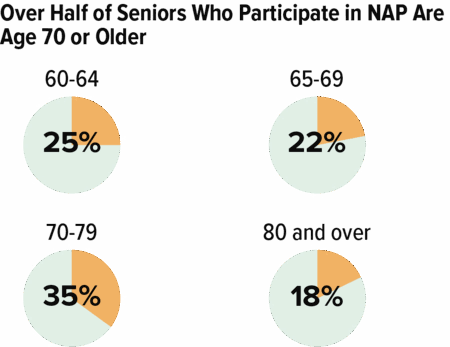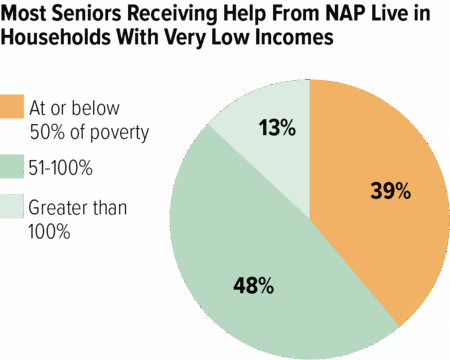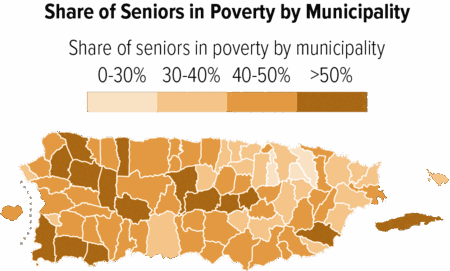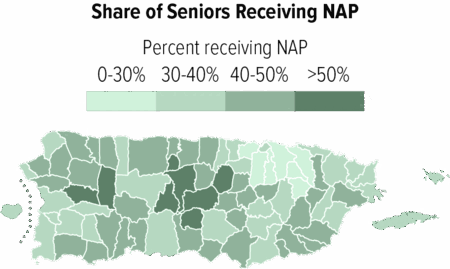- Home
- Food Assistance
- Puerto Rico’s Nutrition Assistance Progr...
Puerto Rico’s Nutrition Assistance Program, NAP (PAN for its name in Spanish, Programa de Asistencia Nutricional), helps about one-third of the Commonwealth’s seniors get enough to eat each month by providing basic monthly food assistance benefits. While the program provides important, targeted support for low-income seniors, NAP’s funding constraints make it less responsive to changes in economic conditions, particularly in contrast to the Supplemental Nutrition Assistance Program (SNAP), the household food assistance program that operates in the 50 states, the District of Columbia, Guam, and the Virgin Islands.
Over 300,000 seniors participated in NAP in a typical month in 2018, comprising about one-quarter of all participants. (This brief captures the role of NAP prior to the COVID-19 pandemic.)
Characteristics of Seniors Participating in NAP
Most seniors participating in NAP have low incomes, in part because the program is targeted toward low-income individuals: close to 90 percent of seniors participating in NAP have income below the federal poverty line, or $20,780 per year for a family of three. About three-quarters of elderly NAP participants receive Social Security as their only source of income.


NAP helps seniors throughout the Commonwealth. It helps more than half of seniors ages 60 and up in some municipalities such as Orocovis, Corozal, Villalba, Florida, and Las Marias.


The elderly population in Puerto Rico is growing, due to declining birth rates, out-migration of younger people, and the aging of the population. The number of elderly NAP participants has grown in turn, and as a result the share of NAP participants who are elderly rose from about 19 percent in 2012 to 24 percent in 2018.

Special Features of NAP for Seniors
NAP has several features that target benefits toward seniors. Seniors can generally apply as a separate household from other individuals they are living with, which can enable them to qualify for higher benefits.
Special features for seniors:
- Rules favorable for benefit calculation and eligibility determination
- Benefit enhancement
When calculating net income, which is used to determine eligibility for NAP and calculate benefit levels, some income such as Social Security income can often be excluded. (For example, for seniors living alone or with other seniors for whom Social Security benefits are their only source of income, only half of this income is counted for purposes of determining eligibility and calculating net income.) This may help some seniors qualify for NAP or qualify for higher benefits. Seniors also receive a small benefit enhancement beyond the base benefit amount, giving them more money to buy groceries.1 In April 2019, households with elderly individuals received monthly benefits of about $188 per month, or about $140 per person. (Participants will receive somewhat higher benefits from July 2019-July 2020 due to temporary federal disaster and emergency relief.2)
Seniors in Puerto Rico Can Access Some, But Not All, Federal Benefits
NAP is important for Puerto Rico’s seniors given high poverty levels in the Commonwealth: about 38.5 percent of all seniors in Puerto Rico ages 60 and up had income below the poverty line in 2018.3 Puerto Rico has never recovered from a recession that began in 2006, and events including two devastating hurricanes, delays in rebuilding aid, and population decline have aggravated those challenges.4
The senior poverty rate would have been much higher without another key program, Social Security. Social Security income lifted 194,000 seniors ages 65 and up in Puerto Rico out of poverty in 2016-2018, reducing the elderly poverty rate significantly.5 Other federal programs, such as nutrition programs for seniors, are also available to help low-income older adults in Puerto Rico.
While many seniors in Puerto Rico use Social Security to help meet their basic needs, they can’t access the federal Supplemental Security Income (SSI) program, which provides benefits to people who are disabled or elderly ages 65 and older with low income and assets in the states and some territories. Instead, Puerto Rico has a capped grant called Aid for the Aged, Blind, and Disabled. The limited funding for this program results in much lower eligibility levels and benefits for low-income seniors and people with disabilities in Puerto Rico than SSI, resulting in very few seniors receiving benefits that are much lower than they would receive if SSI were available.6
In addition, low-income seniors in Puerto Rico with health coverage through Medicaid may have more limited health coverage than they would in the states, due to Medicaid’s funding restrictions in Puerto Rico that have severely limited coverage, benefits, and services.7 Some low-income seniors in Puerto Rico also receive less assistance with Medicare premiums and prescription drug costs than they would in the states.8
NAP’s Funding Structure Limits Its Effectiveness
While these features of NAP help seniors better afford an adequate diet, the program, which is constrained by funding limitations, could be strengthened.
NAP is a block grant with capped funding, which has been flat in recent decades apart from temporary increases authorized by federal policymakers following the Great Recession of 2007-2009 and Hurricanes Irma and Maria. (Puerto Rico also has recently received funding to help the Commonwealth pay for increased NAP costs due to the COVID-19 health and economic crises.)

This funding structure has hampered the Commonwealth’s ability to consistently reach all who would be eligible under SNAP and provide benefits that meet all of its participants’ needs. Meanwhile, SNAP’s funding structure allows the program to provide benefits to all who qualify under the program’s rules, and to expand when the economy worsens or to respond to natural disasters.
Unlike SNAP, which sets eligibility levels based on poverty levels and ties benefit levels to the estimated cost of a nutritious diet, NAP’s eligibility and benefit levels are set to fit the confines of fixed funding. That’s because NAP may not have enough funding to provide benefits based on estimated food needs to everyone who is eligible for the program.
For many households overall, including some households with elderly members, NAP benefits are likely lower than what they would receive in SNAP The different benefit structures and NAP’s targeting to seniors, however, result in higher benefits for other households with seniors relative to what they would receive in SNAP. For some of those households, these higher benefits only partially offset the lack of SSI benefits that they could receive if they lived in the continental United States.9
Notes: Participant characteristics and average benefit amounts come from CBPP analysis of NAP administrative data. In collaboration with Dr.Hector Cordero-Guzman, CBPP obtained de-identified NAP administrative data from the Puerto Rico Department of Family through a request to the Puerto Rico Institute of Statistics. For more information on NAP, see “Introduction to Puerto Rico’s Nutrition Assistance Program,” Center on Budget and Policy Priorities, January 7, 2020, https://www.cbpp.org/research/food-assistance/introduction-to-puerto-ricos-nutrition-assistance-program
Map source: CBPP analysis of 2018 NAP administrative data and Census Bureau annual population estimates and 2014-2018 Puerto Rico Community Survey data
Endnotes:
1 Puerto Rico calculates a base NAP benefit based on household size and net income. The regulations provide that each elderly individual receives a 20 percent increase applied to this base benefit for a household of one, equivalent to about $22 per person per month in 2020, before the program’s regular adjustments are applied.
2 Puerto Rico received $600 million in nutrition assistance in July 2019 to increase nutrition assistance to deal with the ongoing economic effects from Hurricanes Irma and Maria. The Commonwealth also received additional funding from relief packages to deal with costs from the COVID-19 public health and economic crisis. See Puerto Rico Federal Affairs Administration, “Governor Wanda Vázquez Garced Announces $347 million for NAP beneficiaries,” May 18, 2020, https://prfaa.pr.gov/2020/05/18/governor-wanda-vazquez-garced-announces-347-million-for-nap-beneficiaries/.
3 U.S. Census Bureau, “Poverty Status in the Past Year: 2018,” retrieved through Census data explorer, https://data.census.gov/cedsci/table?q=S1701&g=0400000US72&hidePreview=true&table=S1701&tid=ACSST1Y2018.S1701&lastDisplayedRow=16&vintage=2018.
4 Javier Balmaceda, “Long in Recession, Puerto Rico Needs More Than Just COVID-19 Relief to Overcome Its Crises,” CBPP, May 7, 2020, https://www.cbpp.org/research/economy/long-in-recession-puerto-rico-needs-more-than-just-covid-19-relief-to-overcome-its.
5 Kathleen Romig, “Social Security Lifts More Americans Above Poverty Than Any Other Program,” CBPP, February 20, 2020, https://www.cbpp.org/research/social-security/social-security-lifts-more-americans-above-poverty-than-any-other-program.
6 Congressional Research Service, “Cash Assistance for the Aged, Blind, and Disabled in Puerto Rico,” October 26, 2016, https://fas.org/sgp/crs/row/cash-aged-pr.pdf. A U.S. appellate court recently sided with a federal district court in ruling that the exclusion of Puerto Rico residents from SSI is unconstitutional. See Danica Coto, “US court upholds SSI for Puerto Ricans in key ruling,” Associated Press, April 10, 2020, https://apnews.com/908aeca623bc4a07b6c90ad8ac86d047.
7 Judith Solomon, “Puerto Rico’s Medicaid Program Needs an Ongoing Commitment of Federal Funds,” CBPP, April 22, 2019, https://www.cbpp.org/research/health/puerto-ricos-medicaid-program-needs-an-ongoing-commitment-of-federal-funds.
8 The Medicare Savings Program, which assists low-income seniors with their Medicare premiums and cost sharing, does not operate in Puerto Rico, and many seniors pay their own Part B premiums. There is also no Low-Income Subsidy program to help with the cost of prescription drugs, although Puerto Rico gets a separate allotment of funds to provide assistance with prescription drugs for some seniors. For more, see Annie Mach, “Puerto Rico and Health Care Finance: Frequently Asked Questions,” Congressional Research Service, June 27, 2016, https://fas.org/sgp/crs/row/R44275.pdf.
9 For example, the average senior living alone in Puerto Rico has $578 in income and receives $148 in NAP (in April through June 2019, when temporary benefit increases were not in place); this senior would receive about $68 in SNAP. (To calculate the SNAP benefit, which includes a deduction for shelter costs, this example assumes $170 in housing costs, the median housing cost for households with elderly individuals receiving NAP in the past year based on CBPP analysis of the 2018 Puerto Rico Community Survey PUMS data.) If they did receive SSI, however, they would receive about $228 in SSI and $15 in SNAP, giving them more in total benefits than the same household would receive in Puerto Rico.